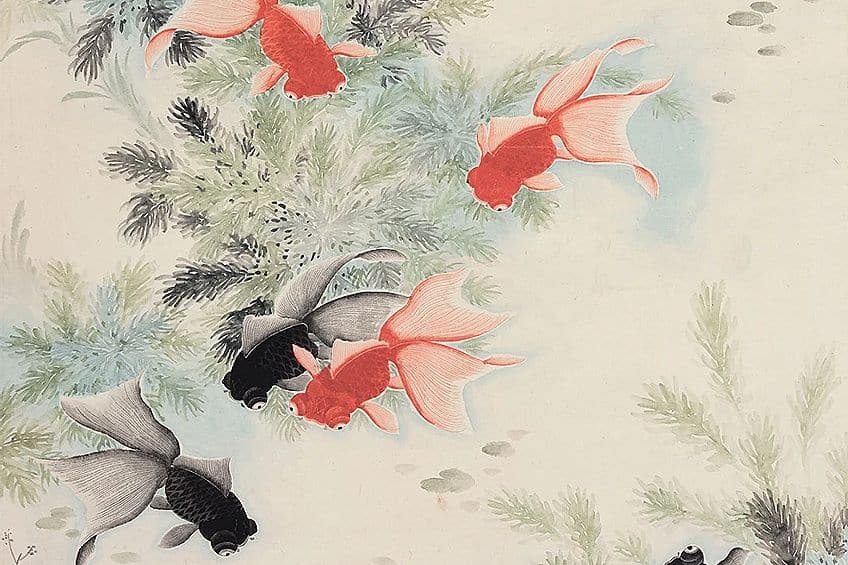Vietnamese Art – The Qualities of Traditional Vietnamese Art
The world of Vietnamese art is incredibly rich and vast, with fascinating artworks dating as far back as 8000 BCE. The influence of Chinese conquests and culture, as well as the impact of cultural change brought on by political change and French art, is also one of the many interesting features of Vietnamese art. In this article, we will introduce you to some of the best Vietnamese art forms, artworks, and artists who have shaped the history of Vietnamese art. Read on for more about Vietnamese art!
A Brief History of Traditional Vietnamese Art
The history of Vietnamese art is deeply rooted in its cultural and political history, spanning Vietnam’s independence from China with many interesting elements of art. Vietnamese art history is divided into different sections, including the Neolithic age, the Bronze Age, the Chinese domination period, the Ngo, and Tran dynasties, the fourth Chinese domination, the Le dynasty, the Nguyen dynasty, and the Modern period. Vietnamese art forms have included the use of materials such as ceramics, clay, stone, steel, paper, bronze, and wood scattered throughout different archaeological sites, which indicate the long history of development in Vietnamese art. Among the many art forms practiced in Vietnamese culture, the most prominent art forms include bronze casting, ceramic sculpture, silk painting, woodblock printing, calligraphy, and porcelain.

Other art forms such as architecture, visual arts, calligraphy, music, material arts, and literature also form part of Vietnamese art history. Below we will take a look at the different periods in Vietnamese art history, as well as the dominant art forms in each Which will give you a broader view of the history of Vietnamese art and help you understand how the different cultures within Vietnam Have influenced the different art forms of Vietnam.
Neolithic Art in Vietnam
Clay pottery was one of the primary art forms of the Stone Age, which dates back to around 8000 BCE. Primitive clear pottery was an art form that dominated the Vietnamese Neolithic era and also demonstrated little signs of decoration and design across archaeological sites such as Bac Son. Ceramic objects called Hoa Loc were products of this art period and included rhythmic designs, which demonstrated the original geometric thinking behind Neolithic objects. The production process of these products involved covering woven objects with clay and storing them in a kiln. Objects would be exposed to high temperatures, which would heat the woven covering until it was burnt. This process resulted in small traces of the burnt woven exterior left on the ceramic jars.
This Vietnamese style of decoration was extremely popular across ancient Vietnamese ceramic products of the Stone Age.
Bronze Age Vietnamese Art
There are three primary stages in the Bronze Age when it comes to looking at Vietnamese art history. These three periods are dated to 4,000 years ago (Phung Nguyen), 3,300 years ago (Dong Dau), and 3,000 years ago (Go Mun). This is when one can observe the increase in complexity when it comes to the development of decorative motifs on different ceramics. Decorating techniques employed during the Bronze Age include bronze objects from the Dong Son civilization, which included intricate incised bands of geometric and circular patterns on Dong Son drums and bronze objects. Some of the most popular images and themes found on Vietnamese Bronze-Age objects and other artworks included scenes from Vietnamese daily life specific to northern Vietnam, as well as images of warriors, animals, musicians, and other interesting subjects. The significance of studying the Vietnamese Bronze Age gives one insight into the early life of Vietnamese Bronze-Age people and their relationship towards art.

Chinese Domination in Vietnam
The Chinese domination period in Vietnam lasted between 111 BCE and 939 CE and saw artworks that were influenced by techniques from China, especially in the realm of ceramics. Evidence of Chinese influence on ancient ceramics. Art from Vietnam. Were found in Chinese tombs through vessel-shaped bowls and vases, which displayed slender necklines and large midsections. Other features from Chinese art found in Vietnamese ancient pottery include terracotta house models and vessels with bell-shaped bases. The Chinese domination period saw an increase in the level of technical expertise in pottery as well as the introduction of the Potter’s wheel, which hastened the development of pottery and allowed for additional visual art styles to be produced.
This included the introduction of yellow and white glazes found over thick-walled ceramic objects.
The Vietnamese Ngo to the Tran Dynasties
Between the Ngo and the Tran Dynasties in Vietnamese art history, there was an increase in the production of Celadon porcelain as well as the influence of important Asian philosophies such as Buddhism, Taoism, and Confucianism. Some of the major influences on Vietnamese ceramics included styles from the Song Dynasty in China and the three-color ceramics from the Tang dynasty. Between 1010 and 1225, the development of Vietnamese ceramics underwent a dramatic transformation, which saw a spark in creativity across the field of design.
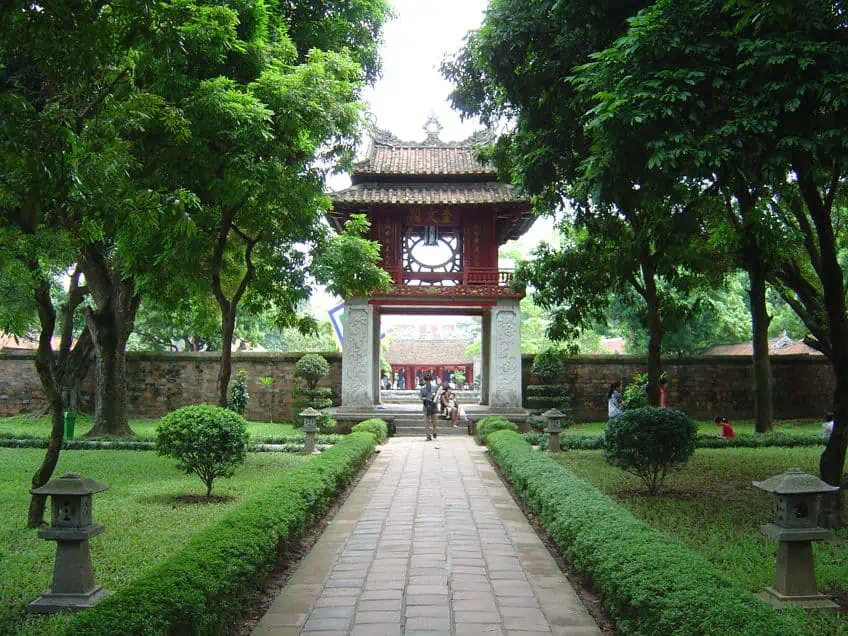
Ceramic art was one of the most dominant art forms of Vietnamese culture and during this period, designs included vessels with more slender shapes and multi-colored glazes. A few popular glaze colors include pale-gray green, white, black, violet-green, and iron-brown hues, which were combined in creative ways to create bold and stunning Vietnamese objects. Along with the influx of creativity directed towards ceramics and sculpture, Vietnamese art also saw a boost in the construction and architecture industry, including the construction of many Vietnam landmarks such as the Temple of Literature, the One-pillar Pagoda, and many other interesting architectural landscapes.
Traditional Vietnamese Art During the Fourth Chinese Domination and Nguyen Period
The fourth Chinese domination was a period of intense upheaval for the Vietnamese people due to the conquest by China, which ultimately affected the survival of many Vietnamese books, artifacts, and artworks. During this era, many Vietnamese artifacts were either pillaged, taken to other lands, or destroyed. The popular art forms were also influenced by the Ming artistic traditions from China. The Nguyen dynasty was the last reigning dynasty of Vietnam, which saw a revival in the production of porcelain and ceramic art. The imperial court had also begun to take a strong interest in the performing arts as well as court music and dance.
Many art forms during the later period of the Nguyen dynasty saw a sharp decline.
Modern Vietnamese Art
The period of modern Vietnamese art began in the 19th century when Vietnamese art was influenced by French art styles. Many French institutions were established at the beginning of the 20th century, including the Fine Arts College of Indochina. Not long afterward, French techniques became popular among Vietnamese artists, resulting in a rise in Modern art. Modern Vietnamese artists employed traditional materials such as lacquer or silk to blend the influence of western art styles and eastern materials. One cannot look at Vietnamese art history without considering the impact of war and propaganda on artistic production. Following World War One, many Vietnamese artists were suffering and faced the pangs of war which only ended decades later. Many of the practicing artists prior to this were drafted into military service from both North and South regions and spent most of their time producing propaganda artworks.
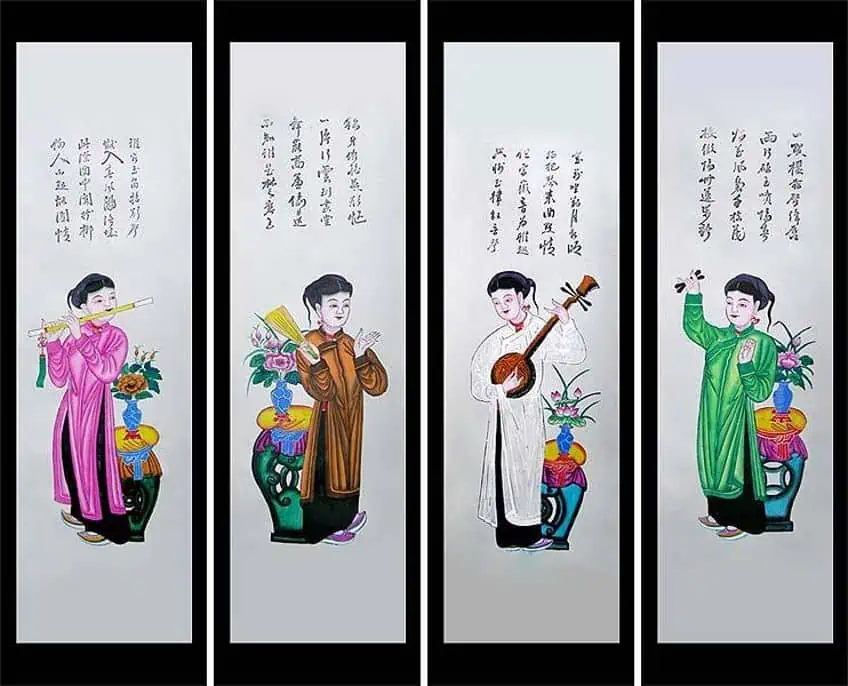
The choice of subject matter for artists was limited and many artists in the North referred to this period as a Socialist Realism era. The Socialist Realism era saw many soldiers and civilians who were encouraged to support the revolution. It is also important to note that there was an absence of literature surrounding global development in the arts, which deprived local artists of exploring alternative modes of creation. Yet, many of the Vietnamese artists looked towards their native folklore as primary sources of inspiration despite their shortage of quality materials such as good canvases and proper paints. Many artists had to find unique and innovative ways to compensate for the shortages. Towards the end of the 20th century, a group of 10 Saigon-based artists established the Vietnamese Young Artists Association, which helped boost the awareness and practice of Modern art in Vietnam.
Late-20th-Century Vietnamese Art
The late 20th century in Vietnamese art was a period of new change, also called the Doi Moi movement of 1986. During this. Artists were exposed to more freedom and could thus explore different themes and modes of expression through which to translate their experiences. The late 20th century also saw the establishment of many art galleries, which garnered significant international attention. This. Was also known as the explosive. In Vietnamese art history as defined by the 1990s. The introduction of travel literature, international magazines, and other forms of external art references in Vietnam allowed young artists to become more confident and take greater strides in creating vibrant and dynamic art.
The gradual influx of global and influential art literature also allowed for the emergence of more independent artists who started exhibiting and promoting their own work.
Vietnamese Sculpture and Ceramics
Now that you’ve gotten a brief overview of the history of Vietnamese art, you can now enjoy a selection of incredible Vietnamese sculptures and ceramic objects that demonstrate the true artistic qualities of Vietnamese sculptors, ceramicists, and porcelain artists.

Ganesha (7th – 8th Century)
| Artist Name | Unknown |
| Date | 7th – 8th century |
| Medium | Sandstone |
| Dimensions (cm) | 96 x 48.5 x 33 |
| Where It Is Housed | Museum of Cham Sculpture, Da Nang, Vietnam |
This sandstone Ganesha sculpture reflects the sophisticated approach of traditional Vietnamese art crafted by Cham sculptors. The Ganesha statue is embodied by a four-armed figure with the head of an elephant and is described as the son of Shiva and Parvati. The image of Ganesha is a manifestation of asceticism, which is highlighted by the pronounced third eye on the sculpture’s forehead. The figure also wears the tiger skin of Rishi, the sage, and was initially discovered at the My Son temple.
The My Son temple is recognized as the religious hub of Cham city. The Ganesha statue is believed to be a work created for a cult derivative of Indian origin.

Phoenix Ewer (15th – 16th Century)
| Artist Name | Unknown |
| Date | 15th – 16th century |
| Medium | Stoneware with underglaze cobalt blue decoration |
| Dimensions (cm) | 29.2 (h) |
| Where It Is Housed | The Metropolitan Museum of Art, New York City, United States |
This Phoenix vessel demonstrates the elegance and refined ornamental attention given to ceramic art in Vietnam. Ceramics produced in Vietnam were characterized by the traditional blue and white designs, which were used for domestic purposes in the 15th and 16th centuries. Many of these items were exported and crafted in fanciful shapes, including animals, and human figures, and took the shape of birds as seen in this Phoenix vessel. This Phoenix vessel is one of several other vessels found in Indonesia which was an active market for the Southeast Asian and Chinese ware community. Many historical Vietnamese kilns created tiles, which were used in the decor of mosques and various other Indonesian buildings.
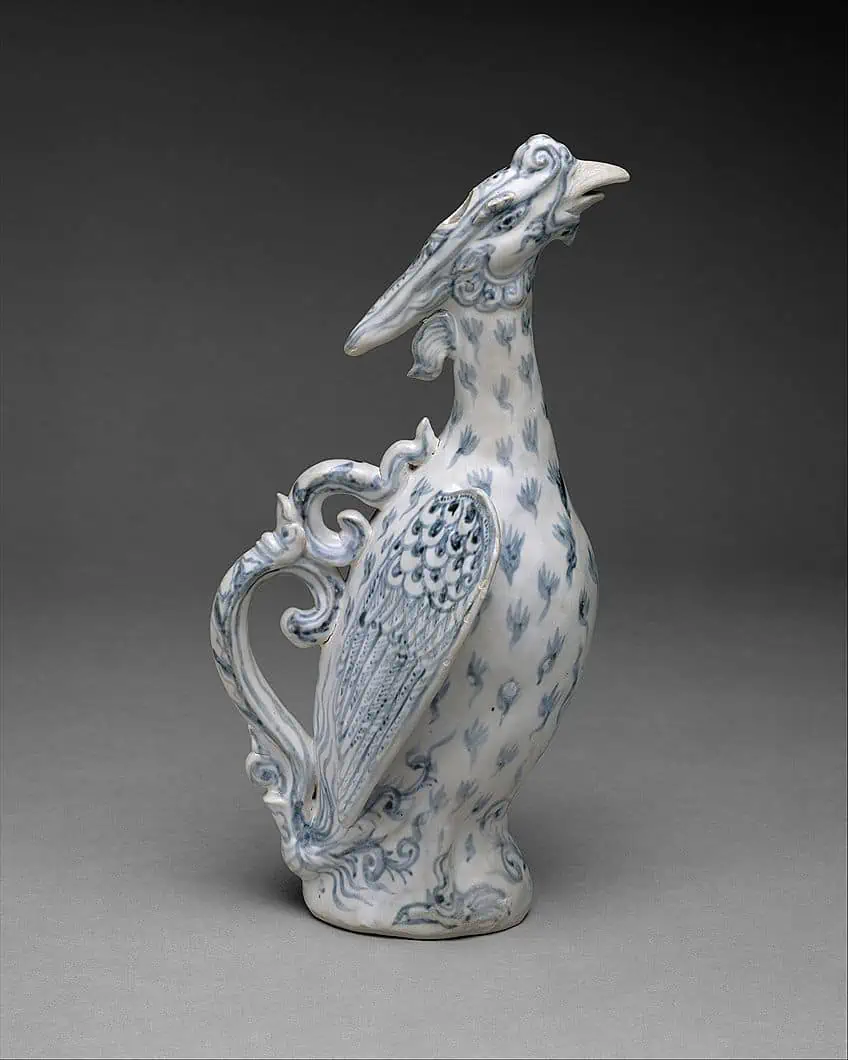
Altar-Vase (c. 1582)
| Artist Name | Unknown |
| Date | c. 1582 |
| Medium | Porcelain |
| Dimensions (cm) | 48 (h) |
| Where It Is Housed | The British Museum, London, United Kingdom |
This Vietnamese altar vase is an ornate vessel from the 16th century, taken from the Mac Dynasty during the Hung Tri period. The vase was crafted from a blue underglaze biscuit-fired porcelain and is decorated with many fiery dragons, rendered with such fine detail and attention to the scales.
This porcelain vase is an example of the regal decoration and shape of vessels that dominated the 16th century and reflects Vietnamese sculpture’s move to early Modern art.

Vietnamese Painting
The art of Vietnamese painting finds its roots in the art of silk painting and lacquerware painting. In this section, we will introduce you to the different forms of painting in Vietnamese art that showcase the variety of techniques that emerged out of the country.
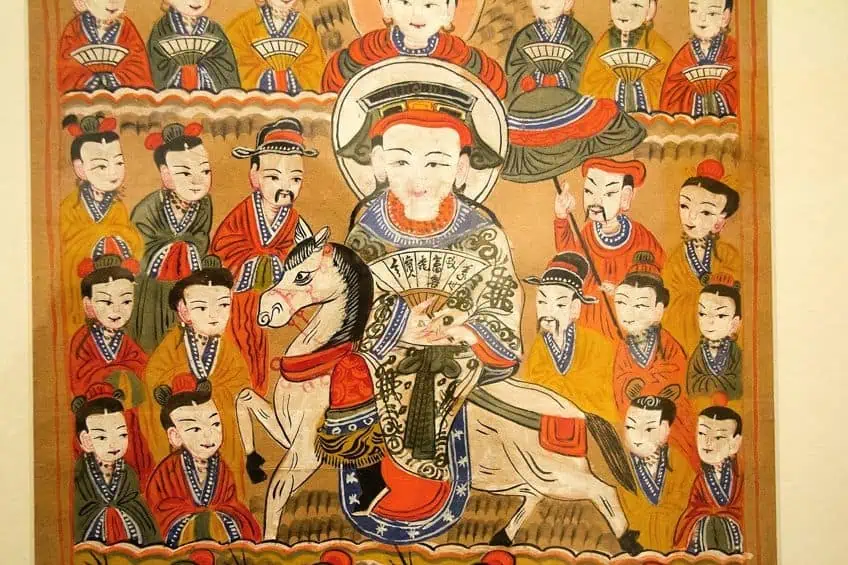
Lacquerware Decoration and Painting
Lacquerware painting is layered and considered to be an ancient art form that involves up to 20 stages in the production process and can span about 100 days. The process is incredibly labor intensive and involves the use of a high-gloss lacquer acquired from the resin of the lacquer tree, which is processed and applied to a wooden base, prepared with an inlay of delicate decorative materials such as egg shells, gold leaf, or mother of pearl. The specialized art form of lacquerware can be traced back to the 18th century in the Hanoi district of Nam Ngu. Lacquerware products were also found in tombs dating back to the 3rd and 4th centuries, which shows just how ancient of a practice the art form is.
The original color palette for lacquerware art included pigments such as red, brown, and black, which evolved to include more vibrant colors used across different sculptural vessels.
Lacquer painting in the fine arts originated in China and developed on its own in Vietnam in the early 20th century after the establishment of the Ecole des Beaux-Arts de l’Indochine around 1925. The art form began receiving global recognition after European art authorities identified the Vietnamese tradition as an art form of its own and encouraged art students to embrace lacquer painting alongside the Western approaches, resulting in a huge boom in lacquer art throughout the next decade. Lacquer paintings preserve well and remain in excellent visual condition for many years due to their lengthy process. Today, many lacquer paintings differ in quality and can be seen at art galleries across Ho Chi Minh and Hanoi.
Silk Painting
While silk painting is an ancient Asian art form practiced across Japan and China, the Vietnamese spin on silk painting offers a unique approach. The traditions of silk painting involve the act of painting on a silk canvas and often portray scenes related to landscapes, the countryside, historical subjects, and pagodas. The soft background of the silk provides a perfect surface to highlight the delicacy of the subject and the medium and requires a hand that has practiced for years to master the material. While there is no shortage of silk paintings in Vietnam, one can look out for the skilled hand of the painter who would bring out the beauty of the silk as opposed to the depiction of the scene.

Vietnamese Contemporary Painting
The Contemporary Vietnamese art scenes are diverse and offer much visual enjoyment to their audience. Different painting styles can be found in Contemporary and Modern Vietnamese painting and range from abstraction and figure painting to detailed landscapes, the natural environment, and themes of beauty inspired by early Vietnamese culture.
Below, we will explore a few emerging Modern and Contemporary paintings by Vietnamese artists that incorporate Western and Eastern techniques and themes.
Figures in a Garden (1907 – 2001) by Le Pho
| Artist Name | Le Pho (1907 – 2001) |
| Date | c. 1907 – 2001 |
| Medium | Oil on canvas on panels |
| Dimensions (cm) | 175 x 209.5 |
| Where It Is Housed | Private collection |
Figures in a Garden illustrate a fragment of the work and artistic oeuvre of Le Pho, who was one of Vietnam’s most celebrated Modern artists. Pho was an educator of the École Supérieure des Beaux-Arts de l’Indochine and was one of the few Vietnamese Modern artists to receive a global stage in Paris. Pho’s paintings reflected his relationship with the Vietnamese landscape and his family with most of his works featuring beautiful still lifes, flowers, and portraits. Pho also focused on the representation of Vietnamese women and painted in his signature style adopted through his exposure to Surrealism via elongated figures. Pho’s palette in Figures in a Garden demonstrates his expert handling of color and his ability to draw out the luminosity of the color to create soft and uplifting scenes that define his view of Vietnam and the relationships he cherished.
Portrait de Mademoiselle Phuong (1930) by Mai Trung Thu
| Artist Name | Mai Trung Thu (1906 – 1980) |
| Date | 1930 |
| Medium | Oil on canvas |
| Dimensions (cm) | 135.5 x 80 |
| Where It Is Housed | Private collection |
Created by famous Modern Vietnamese painter Mai Trung Thu, Portrait de Mademoiselle Phuong reflects Mai Trung Thu was a well-known Modern icon of Vietnamese painting who was also part of the first group of graduates from the École des Beaux-Arts de l’Indochine. Thu’s use of flat color in portraiture creates a calm and serene mood for the viewer. The muted colors also echo the elegance and refined nature of Vietnamese ceramic sculpture while focusing on the sage-green attire of the sitter to evoke a spiritual and pious atmosphere.
The painting is both Modern and classical in its presentation of the sitter who appears poised and comfortable in the presence of the viewer.
Equanimity (n.d.) by Chau Ai Van
| Artist Name | Chau Ai Van (1983 – Present) |
| Date | n.d. |
| Medium | Lacquer on wood |
| Dimensions (cm) | 120 x 80 |
| Where It Is Housed | Nguyen Art Gallery, Hanoi, Vietnam |
Equanimity is a gorgeous Vietnamese painting by Chau Ai Van who currently exhibits Contemporary artworks with Nguyen Art Gallery in Hanoi. Chau Ai Van is recognized as one of the leading painters of Contemporary art within the Hanoi art scene whose works reflect the influences of traditional Japanese woodblock printing as well as Modernist art styles as seen through the sinuous outlines in a few of their works and spatial bold colors. Equanimity is a close-up of the natural landscape, presumed to be a lake or pond as indicated by the water lily pads, flowers, and a dragonfly hovering on the right side of the painting. The colors transport the viewer back in time to embrace an unconventional landscape executed in lacquer paint to preserve the vibrancy of the color and maintain the life of the subject itself.
The art of Vietnam has progressed significantly despite its tumultuous history and relationship with war. The many art forms of ancient Vietnam are to be admired and respected for their unique contributions to the Vietnamese art scene, and are great opportunities to study the traditions and artistic and cultural practices of the country. We hope that you have enjoyed learning about the art of Vietnam, which is certainly worth exploring further!
Frequently Asked Questions
What Are the Different Art Forms of Ancient Vietnam?
The different art forms of ancient Vietnam include silk painting, lacquerware decoration, lacquer painting, monumental sculpture, architecture, ceramic sculpture, porcelain sculpture, and hand embroidery.
Who Are the Most Famous Modern Vietnamese Artists?
The most famous Vietnamese artists include Le Pho, Nguyen Gia Tri, Nguyen Phan Chanh, To Ngoc Van, Nguyen Tien Chung, Hà Mạnh Thắng, Dinh Q Le, Trần Lương, Danh Vō, and Jun Nguyen-Hatsushiba, among many others.
Why Is Vietnamese Art So Popular in the Art Market?
Vietnamese art is considered trendy in the global art market due to its emerging collector base that originated from interested parties across North America, Europe, and Southeast Asia. Through the marketing of Chinese Modern art, Vietnamese art has also seen an increase in international prospectors for the traditional subjects and art styles of Vietnamese art.
Jordan Anthony is a Cape Town-based film photographer, curator, and arts writer. She holds a Bachelor of Art in Fine Arts from the University of the Witwatersrand, Johannesburg, where she explored themes like healing, identity, dreams, and intuitive creation in her Contemporary art practice. Jordan has collaborated with various local art institutions, including the KZNSA Gallery in Durban, the Turbine Art Fair, and the Wits Art Museum. Her photography focuses on abstract color manipulations, portraiture, candid shots, and urban landscapes. She’s intrigued by philosophy, memory, and esotericism, drawing inspiration from Surrealism, Fluxus, and ancient civilizations, as well as childhood influences and found objects. Jordan is working for artfilemagazine since 2022 and writes blog posts about art history and photography.
Learn more about Jordan Anthony and about us.
Cite this Article
Jordan, Anthony, “Vietnamese Art – The Qualities of Traditional Vietnamese Art.” artfilemagazine – Your Online Art Source. April 4, 2023. URL: https://artfilemagazine.com/vietnamese-art/
Anthony, J. (2023, 4 April). Vietnamese Art – The Qualities of Traditional Vietnamese Art. artfilemagazine – Your Online Art Source. https://artfilemagazine.com/vietnamese-art/
Anthony, Jordan. “Vietnamese Art – The Qualities of Traditional Vietnamese Art.” artfilemagazine – Your Online Art Source, April 4, 2023. https://artfilemagazine.com/vietnamese-art/.


